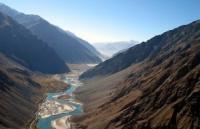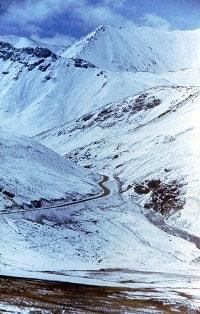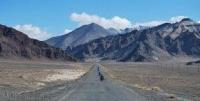You are here
Pamir roof of the world.



Wildflower Holidays in Tajikistan.
“The world is a book and those who do not travel read only one page”
Augustine of Hippo.
Photos of the mountains of Tajikistan.
Pamir is one of the phenomenal mountain range which forms a high ground for the great tectonic balance in this region of the world. In the southwest it runs into Hindukush range buttressing the little intermediary ranges.
Tien-Shan range skirts the northeastern part of the region running into China, Kyrgyzstan, Kazakhstan and Uzbekistan. To its higher plateau, the term Pamir knot is often applied owing to its relationship with neighboring ranges.
Pamir is one of the highest and remotest part of our region which covers a huge rugged territory. The region of Badakhshan is rich in mineral wealth and from the time of our histories, it has been known for its precious and semi precious stones of which rubies and lapiz lazuli mines were well sought for.
The Tajik part of the Pamirs was well mapped and explored during the early Tsarist days. The two players of the Great Game equally eager to out maneuver each other were involved in exploration and mapping the region to their respective political gains.
The harsh nature of the climate in the Pamirs kept the civilized settlements away giving rise to a semi nomadic culture that exists in various enclaves of the region. The winter temperatures freeze down to -47C with due to high glaciated table in the region.
Due to acute climatic conditions, vegetation is poor and mostly shrubs like juniper and tamarisk grow along the watery part of the area with wild vegetation of artemisia, caper and other shrubs grow in unsettled areas. In more settled villages we see willows, mulberry, pistachio, apricot and poplar trees grow in good number giving protection to the settlements against the erosion.
The Wakhan part is in Afghanistan which is the highest plateau, known by the travelers as ‘Bam-i-dunya’ – Roof of the World. These high parts are inhabited by Kirghiz nomads living for almost a century moving out of mainland due political changes.
Now they form a part of Afghan nationality and live on the breeding of fat tailed sheep. They have been moving along the wild frontiers and often trespassing in the regional territories but going un-noticed due lack of control.
During the Soviet war in Afghanistan this tribe of Kirghiz nomads traveled through the traditional routes taking refute into northern parts of Pakistan. Being Turkic speakers the Govt. of Turkey took the tribe enbloc for temporary settlement in the mountainous region.
Now with the end of war in their parts they have started coming back to their natural homeland. One can see their camels grazing in the lower parts along the river Peyanj and Sarhad darya. In the upper reaches, river Payanj forms a natural boundary between Tajikistan and Afghanistan.
The settlements across the river into Afghanistan are very few and mostly concentrated around the lower reaches while along Tajikistan border line, villages are well dressed with fields and activity. A careful eye can always see hair raising paths which remind us of the Silk Road days and still being used along the Afghan border.
As one travels in to the mainland of the Pamirs starting with bigger settlement of Roshan town and then into the heart of the valley at Khorog are the concentrated part of the region in terms of population. As one moves to the higher Pamirs these villages thin out to mere small group of cattle houses.
The population living in the upper parts generally known as Tajiks of the Pamirs are a group of population which may have settled around the first millennium BC when the Aryan migration took place into these parts.
This racial group can safely be termed, as an admixture of Iranian and Caucasian blood. These racial groups all along both sides of river “Oxus” are speakers of various Pamiric languages and dialects of Indo-Aryan nature.
These subgroups are then extended into all along the Wakhan and the northern parts of Pakistan. It is very interesting to make the comparisons as from the ancient times these people have been traveling into the Wakhan corridor being a passage onto the Chinese and Pakistani side of the border in search of food products.
Well this passage in the heart of Wakhan was the natural route of the Pamir branch of the Silk Road. Before the frontiers were drawn, Pamiris used to come down to the then, North Western part of the British India and this activity continued for a long time till the advances of the Great Game players checked their traditional movements.
The region around 06th 07th Century BC was invaded by Scythian tribal hordes infesting Transoxiana kingdoms by their ravages. They were brought under control by the Persians whose Achaemenian Empire around VIh Century BC had established authority into these parts out of Bactrian region.
This is the beginning of a civilized life in the lower reaches of the Pamirs. The Persian activity and control continued till the arrival of Alexander the Great around 325BC who was by then asserting his claim over the lost empire of the Achaemenids.
We are not sure whether he himself ever came to the higher Pamir regions, but he was very well in the lower areas which were part of the Bactriana region. The Seleucids who founded the Greco Bactrian Kingdom in 323 BC were the sole rulers of a huge region which also included Pamir and the Wakhan.
But it must have been the later Indo-Bactrian Greeks whose inter tribal warfare was aggressive in asserting their control of these regions around the turn of 1st BC. We see many small Greek colonies established along the river.
In the Museum of Antiquities in Dushanbe, one can see collection of artifacts with Greek influence found from various archaeological sites of the region. Similarly on the Afghan side we see the existence of such sites like Ai Khanum.
The resurge of Persians under the Parthians and Sassanids had a great influence on the Silk Road movement due to the establishment of links with the Eastern Romans. Taking the advantage of their position, they played the role of intermediaries of the Silk Trade.
These were the times when silk was introduced to the Romans. As mentioned the Pamir branch of the Silk Road, passed through the Wakhan corridor and followed the natural route along the Oxus river down to Bactriana(Balkh).
The brisk activity on the Silk Road started during the Kushana empire which was well established and was prospering around 1st AD. There was a line of developed villages along the river and the other parts of the region, involved in commercial activity.
We can still see ruins of old forts on the hill tops, standing today as the silent spectators of a grand past when they serve as the outposts for managing safe passage to the caravans coming from China. Today the people of the Pamir region are predominantly Ismailis(followers of Agha Khan) and it is interesting to see, carrying of Zoroastrian rituals imbibed with spirit of Islam.
You can always see signs of fire burning hearths at almost all the shrines found along the Pamir region. The curious style of house building is a continuation of Iranian building traditions which is seen further into the northern parts of Pakistan.
We often come across houses and shrines decorated with trophy heads of ibexes and Marco Polo sheep as these animals have always been hunted down for meat. The pre-historic significance of ibexes scratched on the stones finds its décor on houses and secular buildings.
The journey of the great traveler Marco Polo in XIIIth Century through the Wakhan corridor was of great interest. He saw the curly headed sheep in the Pamir plateau and mentions about, huge numbers roaming on the plateau and the nearby valleys.
This animal whose curly horns could grow more than two meters, was later known after the great explorer as ‘Marco Polo’ sheep (ovis amon poli). While travelingalong the route into the mainland Badakshan he mentions about the ‘rubies of Badakshan’ and one can still see the quarry mine from the road while nearing Iskashim.
He then after resting at Iskashim visited the court of the King of Badakhshan in Faizabad. Traveling along the river Oxus one can see beautiful views of the Wakhan mountains that will chase you all the way down to Kala-i-Khum.
The best season for travel along the Pamir region is August till the end of September. The spring time here blossoms around May which is greener and nice to look at the general scenery. The main towns of interest are Rushan – see the old fort and the shrines of local saint.
Khorog is interesting visit the Museum, the library dedicated to Nasir-i-Khisrow who brought the message of Islam into these parts. Later further up Khorog an excursion to Garam Chasma(hot springs) is recommended for a healthy dip. Iskashim, Leyangar and Murghab are stopovers for spending the nights.
The accommodation is pretty basic and one should be prepared for carrying supplies and extreme conditions.
Authority:
Sitara International Ltd. http://www.discovery-central-asia.com







